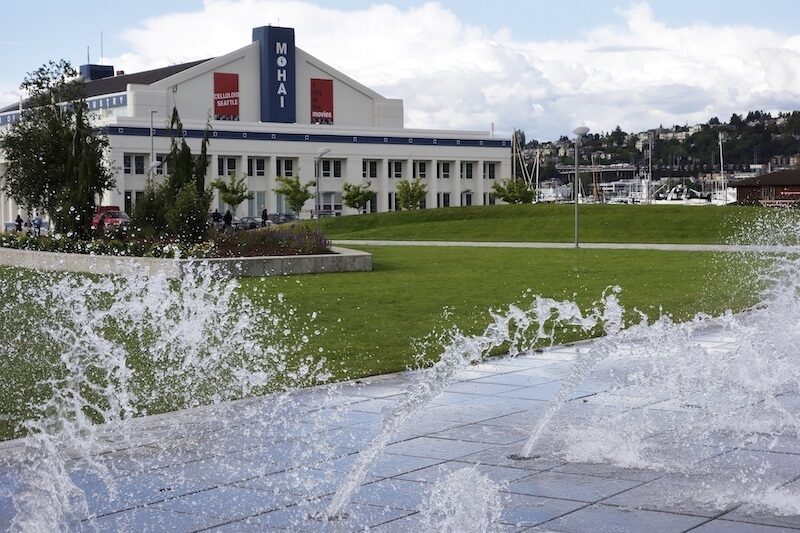MOHAI’s Creating a Neighborhood Scavenger Hunt Creates Community Too
Review of Creating a Neighborhood: Democracy on a Human Scale Scavenger Hunt presented by Museum of History and Industry
Written by Teen Editor Eleanor Cenname and edited by TeenTix Teaching Artist Sarah Stuteville

The pandemic has lowered our standards for art. At least, I think that it has lowered mine. While watching virtual plays or clicking through online art galleries, I am reliably disappointed by the lack of energy. There is no moment of serendipity as you and a stranger admire the same sculpture, no shared laugh between audience members of an improv sketch. An ongoing exhibit at the Museum of History and Industry (MOHAI) shatters this thought. Creating a Neighborhood: Democracy on a Human Scale Scavenger Hunt is not just good for a virtual museum experience, it is simply a great museum experience.
Creating a Neighborhood: Democracy on a Human Scale distinguishes itself through its scavenger hunt format and goes beyond the hackneyed Google Street View layout of many virtual museums. The brave souls who embark on this scavenger hunt walk a one mile ‘trail’ starting at the MOHAI building. Participants stop at eight locations, each representing a moment when civic engagement shaped Seattle, such as with the construction of the Naval Reserve Armory. Now the MOHAI building, the Naval Reserve Armory was built after citizens lobbied for its construction. As the exhibit explained the physical impact of citizens’ civic actions on the composition of the city from its parks, industry, and public art, it was enthralling to imagine what might have been. What would we see now had white settlers not ousted the Coast Salish people from the city? How would Seattle be different with a 61-acre park, which would have been called The Commons, stretching from South Lake Union to Downtown? What would Seattle be without Microsoft?

By far, the most delightful component of this exhibit was the opportunity to virtually interact with fellow museum-goers despite the pandemic. At the various stops, the platform asks the scavenger questions such as “What changes would you advocate for in your community?” to which visitors wrote “more libraries” and “community gardens and green space.” It also encourages visitors to take pictures at some of the locations and post them in the gallery that is available on the virtual exhibit platform at each destination. These options transcended the superficial click-through-and-done format to facilitate something akin to a conversation. For all of us the past year has been challenging and dark. The exhibit forged a moment of connection and collective learning, and it reignited the spark that is often missing in online arts events.
The exhibit is also unique in that it does not present its historical information in the abstract. Instead, it contextualizes the information, immersing its viewers in the moment by taking them to each location referenced in the exhibit. This ability allows us to see history as something growing and almost living, something that is always in flux.
MOHAI’s Creating a Neighborhood: Democracy on a Human Scale cultivates a true sense of adventure. It was a celebration of the everyday, of the fascinating histories of spaces that we might travel past without a second thought. For example, the Cascade Neighborhood, where I often travel through, was once a space intended to provide housing to low-income young people. Through allowing participants to walk through the places that it references, the exhibit cultivated a personal connection to the historical places that it referenced.
The truth is virtual events will never be the same as in-person events. And maybe they should not be. Creating a Neighborhood: Democracy on a Human Scale Scavenger Hunt shows us that virtual museum experiences can be rich and fascinating, not in spite of the medium, but because of it. We do not need to replace the in-person events that would have been with a meager online alternative. Instead, we can think creatively and do something different, that a different way of doing things can be thrilling. The pandemic has allowed us to reflect on the way we go about our lives. It has forced us to step back, turn inwards, and consider other ways of being. The shift has happened in the way we do school or work, the ways that we socialize and take care of ourselves, and now it is evident in the way we consume art. And certainly these new ways of approaching life are not worse or better, but we can allow ourselves to enjoy the good that emerges because they are different.
Lead photo credit: Photo courtesy of Museum of History and Industry.
This review was written as part of mentorship program where members of the Teen Editorial Staff receive one-on-one mentorship by Press Corps Teaching Artists and professional critics. The Teen Editorial Staff is made up of 6 teens who lead the TeenTix Newsroom and curate the review portion of the TeenTix blog. More information about the Teen Editorial Staff can be found HERE.
The TeenTix Press Corps promotes critical thinking, communication, and information literacy through criticism and journalism practice for teens. For more information about the Press Corps program see HERE.


